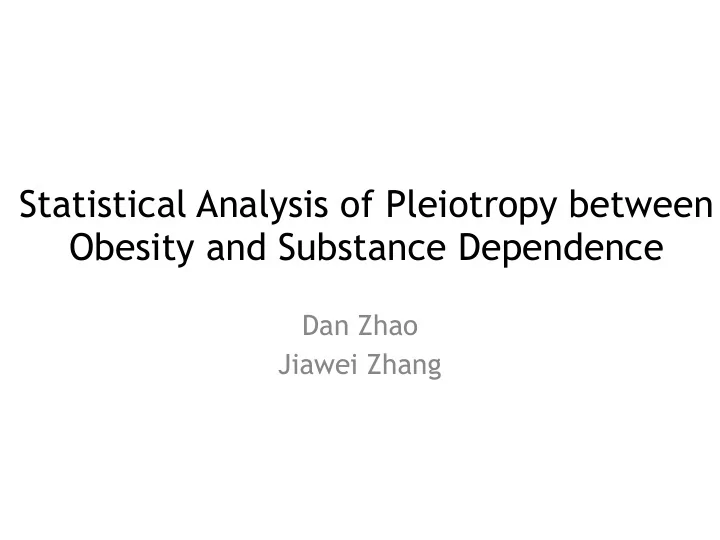

Statistical Analysis of Pleiotropy between Obesity and Substance Dependence Dan Zhao Jiawei Zhang
Data • SSADDA : 2379 European Americans • SAGE : 2668 European Americans • Phenotype : BMI, Substance dependence symptom score; • Genotype : 988,306 SNPs (SSADDA)
Quality Control a. Misidentified individuals a. MAF 0.01 b. Genotype failure rate 0.02 b. HWE 1e-06 c. Genotype missing rate 0.02 c. Extreme heterozygosity (+/-3 sd) d. Unbalanced genotype rates d. Duplicated or related between case/control individuals p=1e-05 • Sample QC • SNP QC • (2379=>1828) • (988,306=>805,782)
Before QC After QC From PCA plots, most suspected outliers have been removed in the quality control (QC) process.
Single Marker Association Analysis • Genotype Model : additive model – Assume there is a linear increase of risk with each additional risk allele. • Test Approach : linear regression • Covariates : adjusted in linear regression – Age and sex – first 4 scaling factors from MDS analysis (for population stratification)
Outcome: BMI rs1121980 Inflation factor λ =1.02
SNP CHR Nearest Gene Beta P-value rs1121980 16 FTO 0.9207 2.26E-06
Outcome: Sub_Dep Inflation factor λ =1.007 rs2010884
SNP CHR Nearest Gene Beta P-value rs2010884 6 OPRM1 -1.39 4.18E-06
Mixed Effects Model Based Analysis Y = X β + u + ε • Y=phenotypes • X=SNP genotypes (+covariates) • , where A is the genetic 2 A Var ( u ) = σ g relationship matrix (GRM) ( g ij − 2 p i )( g ik − 2 p i ) A jk = 1 ∑ 2 p i (1 − 2 p i ) M i
Outcome: BMI rs1121980
Outcome: Sub_Dep rs2010884
Heritability Estimates Y = X β + u + ε • , is the variance explained by 2 2 A σ g Var ( u ) = σ g all the SNPs • Estimated by the restricted maximum likelihood (REML) approach Phenotype N Hg SE LRT P-value BMI 1828 0.2595 0.16 2.917 0.0438 Sub_Dep 1828 0.2156 0.16 1.890 0.0846
SNP Coheritabilities • The variance-covariance matrix across the two traits is: ' + I σ g 1 ⎛ ⎞ 2 ' σ g 12 Z 1 AZ 1 Z 2 AZ 1 ⎜ ⎟ V = ' + I σ g 2 ' σ g 12 2 Z 1 AZ 2 Z 2 AZ 2 ⎜ ⎟ ⎝ ⎠ • The genetic correlation coefficient is: σ g 12 r g SNP = σ g 1 + σ g 2
• Estimated by the Bivariate REML approach N r G S.E. P-value BMI:Sub_Dep 1828 0.2408 0.41 0.71
Integrative Analysis of Two GWAS Datasets with Functional Annotations • We have P-values from two independent GWAS datasets • Indicator variable Z j =[Z j00 ,Z j10 , Z j01 , Z j11 ] for the j-th SNP: e.g, Z j11 means the j-th SNP is associated with both BMI and Sub-Dep A j ∈ {0,1} • Functional annotation data: , where A ∈ ! M indicates whether the j-th SNP is functionally annotation.
• Model the relationship between Z j and A j as: q 00 = Pr( A j = 1| Z j 00 = 1) 10 = Pr( A j = 1| Z j 10 = 1) q q 01 = Pr( A j = 1| Z j 01 = 1) 11 = Pr( A j = 1| Z j 11 = 1) q • The joint distribution of Pr (P , A) can be estimated by EM algorithm M ⎡ ⎤ Pr( P , A ) = Pr( Z jl = 1)Pr( P j , A j | Z ij = 1) ∏ ∑ ⎢ ⎥ ⎣ ⎦ j = 1 {00,10,01,11} l ∈
• The summary statistics of two phenotypes: BMI: 805,782 p-values; Substance Dependence: 845,871 p-values; • Overlapping SNPs of two phenotypes is 466,115 • Using the central neural system gene as annotation data, 63,274 (13.6%) of the SNPs were annotated 00 10 01 11 ˆ 0.911(0.086) 0.046(0.053) 0.04(0.084) 0.02(0.049) π ˆ 0.126(0.013) 0.213(0.094) 0.268(0.086) 0.288(1.843) q
Conclusion • The strongest association signal for obesity: FTO gene; • The strongest association signal for substance dependence: OPRM1 gene • estimated for obesity was 0.26, 0.22 for 2 h g substance dependence • No evidence suggests pleiotropy between obesity and substance dependence in this data set.
Recommend
More recommend